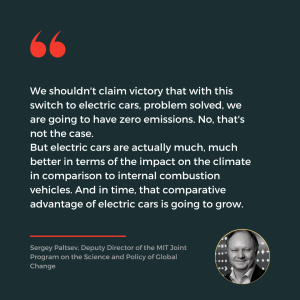Hardly makes any noise, does not emit any smelly exhaust fumes, and contains a lot of the latest technology – at least that is the general perception of electric vehicles. However, electromobility is much more than that; emission-free electric motors, fed with climate-neutral energy, are the technological promise that should lead us into a more environmentally friendly future.
Many people and many companies are switching over: Instead of vehicles with combustion engines, they prefer to use climate-friendly electromobility. Such a massive changeover naturally raises questions – including the environmental impact. We have tried to answer some frequently asked questions here.
🔴Remember, the best way to lower your carbon footprint is to choose public transit, active transportation (e.g., bike, walk, electric skateboard), or shared electrified travel. These options are also the most cost-saving, too!
1. Are EVs a better environmental option?
Our answer is YES: although many fully electric vehicles (EVs) carry “zero emissions” badges, this claim is not quite true. Battery-electric cars may not emit greenhouse gases from their tailpipes, but some emissions are created in the process of building and charging the vehicles.
One source of EV emissions is the creation of their large lithium-ion batteries. The use of minerals including lithium, cobalt, and nickel, which are crucial for modern EV batteries, requires using fossil fuels to mine those materials and heat them to high temperatures. As a result, building the 80 kWh lithium-ion battery found in a Tesla Model 3 creates between 2.5 and 16 metric tons of CO2 (exactly how much depends greatly on what energy source is used to do the heating). This intensive battery manufacturing means that building a new EV can produce around 80% more emissions than building a comparable gas-powered car.
But just like with gasoline cars, most emissions from today’s EVs come after they roll off the production floor. The major source of EV emissions is the energy used to charge their batteries. These emissions, says Paltsev, vary enormously based on where the car is driven and what kind of energy is used there. The best-case scenario looks like what’s happening today in Norway, Europe’s largest EV market: the nation draws most of its energy from hydropower, giving all those EVs a minuscule carbon footprint. In countries that get most of their energy from burning dirty coal, the emissions numbers for EVs don’t look nearly as good—but they’re still on par with or better than burning gasoline.
Currently, China dominates the electric vehicle battery market, producing the majority of the world’s supply. That’s notable because China’s grid is largely powered by coal. Though this condition still results in an electric vehicle producing fewer emissions (over its entire life cycle) than a traditional vehicle, there’s clearly room for improvement.
Many auto manufacturers are brokering partnerships with other supplier countries, such as South Korea and Japan (both of which enjoy cleaner fuel mixes). In addition, the global auto industry is expanding battery manufacturing opportunities in North America and Europe to produce the greenest electric vehicle possible.
2. Can EV batteries be recycled?
Ok, so if we use a clean energy mix while charging our vehicles and manufacturing their batteries, we’re all good, right? Not so fast.
What happens to all those batteries in about 10 years, when they must be replaced?
Mirroring the recycling programs for small electronics that now exist in many big-box stores, there’s a huge effort under way to meet this reuse-and-recycle challenge. Some auto manufacturers, like Nissan and Volkswagen, are already re-purposing these batteries in secondary applications within their own factories.
Concerned about where electric car batteries go after they’ve been used? EV batteries can actually be recycled and repurposed. Read about it in our guide.https://t.co/V0QVZZ3hOp#ev #electriccars #batteries #recycle #greencars #guide pic.twitter.com/wvdxIddlzw
— GreenCars (@GreenCarsHQ) August 4, 2021
There are also promising early results in a 2020 study from the Massachusetts Institute of Technology showing electric vehicle batteries could have a useful and profitable second life as backup storage for grid-scale solar photovoltaic installations. As this role would be less demanding than powering a vehicle, researchers estimate the batteries could perform for more than a decade in such a capacity.
Lastly, some auto manufacturers are already recycling their electric vehicle batteries, though these efforts will have to scale up as more electric vehicles hit the road.
Visualizza questo post su Instagram
3. Are electrically chargeable vehicles the future of road transport? Will they eventually replace conventional combustion engine vehicles?
The term ‘electrically chargeable vehicle’ covers a wide range of technologies. From the perspective of the industry, there are several basic types of electrically chargeable vehicles. Electrically chargeable vehicles have a place on Europe’s roads, and their use is growing. Presently the industry predicts that in 2025 electrically chargeable vehicles will make up 2%-8% of the market, depending on how quickly the various technological, infrastructure, and socioeconomic challenges can be addressed. Even as the electrically chargeable vehicle develops, the industry expects that for the foreseeable future, the combustion engine will remain the dominant and most popular propulsion method, buttressed by alternative and hybrid drivetrains. Over time this may change as consumers become used to the vehicles and as infrastructure develops. However, it is difficult to predict precisely what future developments may lead to. And therefore relevant legislation in the EU institutions should continue to be ‘technologically neutral’.
4. Does battery production cause CO2 emissions?
It depends exactly where and how the battery is made—but when it comes to clean technologies like electric cars and solar power, even the dirtiest batteries emit less CO2 than those using no battery at all.
Exactly how much CO2 is emitted in the long process of making a battery can vary a lot depending on which materials are used, how they’re sourced, and what energy sources are used in manufacturing. The vast majority of lithium-ion batteries—about 77% of the world’s supply—are manufactured in China, where coal is the primary energy source. (Coal emits roughly twice the amount of greenhouse gases as natural gas, another fossil fuel that can be used in high-heat manufacturing.)
Exponential rise in the use of lithium-ion batteries in the world will be seen over the next decade #Lithium #batteries #EV #Solar #WaareeTech 🧘🏻♂️ pic.twitter.com/9uijkI8nfA
— Mayank Gupta (@MunkThePunk) February 16, 2023
For illustration, the Tesla Model 3 holds an 80 kWh lithium-ion battery. CO2 emissions for manufacturing that battery would range between 2400 kg (almost two and a half metric tons) and 16,000 kg (16 metric tons). Just how much is one ton of CO2? As much as a typical gas-powered car emits in about 2,500 miles of driving—just about the same weight as a great white shark!
Researchers across the globe are trying to design new manufacturing processes or new battery chemistries that can work with more readily available, environmentally-friendly materials, but these technologies aren’t yet available on a wide scale.
Despite the environmental footprint of manufacturing lithium-ion batteries, this technology is much more climate-friendly than the alternatives, Shao-Horn says.
In the United States, the electric grid (which is a mix of fossil fuels and low-carbon energy such as wind, solar, hydropower, and nuclear power) is cleaner than burning gasoline, and so driving an electric car releases less CO2 than driving a gas-powered car.
“An electric vehicle running on [electricity generated with] coal has the fuel economy equivalent in the order of about 50 to 60 miles per gallon equivalent,” says David Keith, a professor at the MIT Sloan School of Management who studies the emergence of new technologies in the automotive industry.
“So the dirtiest electric vehicle looks something like our best gasoline vehicles that are available today.”
And an electric vehicle running on electricity generated by hydropower, solar, wind, or other low-carbon energy sources can be significantly cleaner.
5. Are there sufficient reserves of lithium to ensure stable battery production?
According to the U.S. Geological Survey (USGS), Earth plays host to some 88 million tonnes of lithium. Of that number, only one-quarter is economically viable to mine (this is known as “reserves”). Luckily, Earth’s total reserves of lithium will likely increase as technology improves. For example, the USGS estimated only 13 million tonnes of lithium on Earth just a decade ago.
Lithium is the new oil.#lithium #ev #oil pic.twitter.com/3KAbyTrmNX
— SUJIT G VARTI (@sgvarti) February 23, 2023
The biggest challenge is justified is in answering how we’re going to extract the necessary amount of lithium in the first place.
This brings us to maybe the greatest challenge of the EV revolution: how to quickly mine lithium (to start the green tech revolution our planet desperately needs) while not leaving behind a litany of ecological disasters and human rights abuses in our wake.
Lithium mines use a lot of water—many thousands of gallons per minute, according to The New York Times—and groundwater contamination with antimony and arsenic are a real and persistent threat. Other side effects of lithium mines include biodiversity loss, soil erosion, and air quality degradation—and that doesn’t even include what moving mining operations to the ocean floor could do.
Innovation can offer hope. One mining operation in Manitoba, Canada, is working to be a renewable and sustainable lithium mining operation with nearly all of its power drawn from hydroelectric energy, while also banning diesel-burning trucks and equipment. Increased efficiency in lithium recycling could also be a major boon to making these reserves last longer.
If more mining operations follow suit, we can hope to have an electrified future worth saving.
Do you have questions about this topic? feel free to drop your doubts with a comment below 😉


